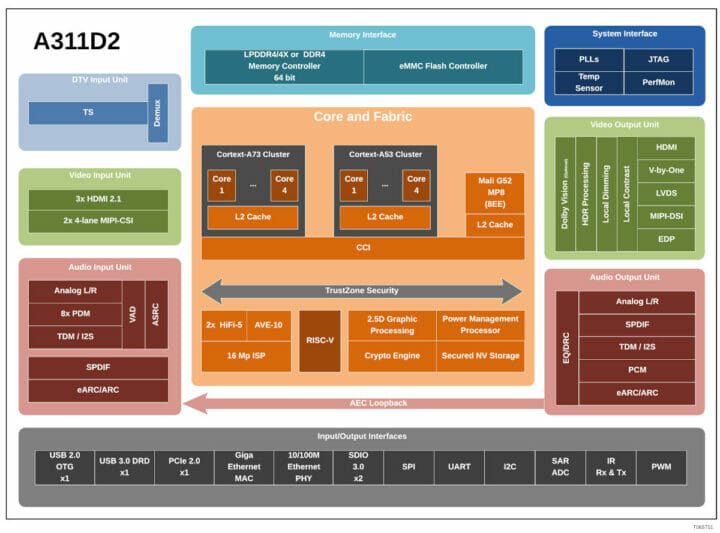Amlogic A311D2 octa-core processor is the successor to Amlogic A311D hexa-core SoC with four Cortex-A73 cores, four Cortex-A53 cores, a more powerful Mali-G52 MP8 (8EE) GPU, support for eDP and LVDS video interface, 8Kp24 AV1 video decoding, and support for a whopping 16GB LPDDR4/X memory.
But it’s not all! The chip also includes supports for three HDMI 2.1 inputs up to 4Kp60, a 16MP ISP, 4K video encoding, and the more powerful GPU and higher memory bandwidth enable 4K user interfaces which were not feasible on most other Arm hardware barring the NVIDIA Shield.
 Comparison of Amlogic A311D2 and A311D specifications.
Comparison of Amlogic A311D2 and A311D specifications.
| Model | Amlogic A311D | Amlogic A311D2 |
|---|---|---|
| CPU | 4x Cortex-A73 at 2.2GHz, 2x Cortex-A53 at 1.8GHz | 4x Cortex-A73 at 2.2GHz, 4x Cortex-A53 at 2.0GHz |
| GPU | Arm Mali G52 MP4 (6EE) at 800MHz | Arm Mali-G52 MP8 (8EE) |
| NPU | 5 TOPS | TBC, extra license required |
| RAM | Up to 4GB 32-bit LPDDR4/X @ 1608MHz | Up to 16GB 64-bit LPDDR4/X @ 2133 MHz |
| Display I/F | 1x HDMI 2.0 up to 4Kp60 1x MIPI DSI | 1x HDMI 2.1 port up to 4Kp60 with EMP, ALLM, VRR, QMS, eARC, etc... 2x MIPI DSI up to 1920x1080 LVDS 2x 8-lane V-by-One up to 4Kp60 2x 4-lane eDP up to 2560x1600 |
| Camera I/F | 1x 4-lane MIPI-CSI with 8MP ISP | 2x 4-lane MIPI-CSI with 16MP ISP |
| HDMI Input | No | 3x HDMI 2.1 up to 4Kp60 |
| 4K UI | No | Yes |
| Video Decoding | 4Kx2Kp60 + 1x1080p60 |
|
| Main Video Codecs | 4K H.265, VP9, and AVS2 | 8Kp24/4Kp60 AV1, H.265, VP9, 4Kp60 AVS2 |
| Video Encoding | H.265 & H.264 at 1080p60 | H.265 & H.264 at 4Kp50 |
| Ethernet | Gigabit Ethernet MAC Fast Ethernet PHY | Gigabit Ethernet MAC Fast Ethernet PHY |
| USB* | 1x USB 3.0 multiplexed with PCIe 1x USB 2.0 with OTG support | 1x USB 3.0 1x USB 2.0 with OTG support |
| PCIe* | 1-lane PCIe multiplexed with USB 3.0 | 1-lane PCIe |
| Process | 12 nm |
|
* Amlogic A311D multiplexed PCIe and USB 3.0 interfaces means two configurations are possible: 1x USB 2.0 Host + 1 PCIe, OR 1x USB3.0 (No PCIe), but Amlogic A311D2 PCIe and USB 3.0 interfaces are independent, so we are not losing USB 3.0 when using PCIe (5 Gbps).
The quick reference manual does not include any specific information about an AI accelerator, except for an optional dual HiFi 5 audio DSP with Neural Network Extension for audio/voice processing, so there’s no indication about an NPU for computer vision application, but we’ll have to see. At first, I thought Amlogic A311D2 may be a variant of the long-expected Amlogic S908X, just like A311D and S922X-B are practically the same processor, but while 8K video decoding is supported, 8Kp60 video output is not.
I would only expect Amlogic A311D2 to outperform A331D in terms of CPU power in highly parallel tasks, but the real improvements are with the GPU, 4K video encoding, HDMI 2.1 features support, separate USB 3.0 and PCIe interfaces, HDMI inputs, and obviously the extra RAM, which would allow new applications such as multiple camera NVR’s, more powerful and versatile Arm Linux mini PC’s, SBC’s with additional high-speed interfaces, etc…

Jean-Luc started CNX Software in 2010 as a part-time endeavor, before quitting his job as a software engineering manager, and starting to write daily news, and reviews full time later in 2011.
Support CNX Software! Donate via cryptocurrencies, become a Patron on Patreon, or purchase goods on Amazon or Aliexpress




